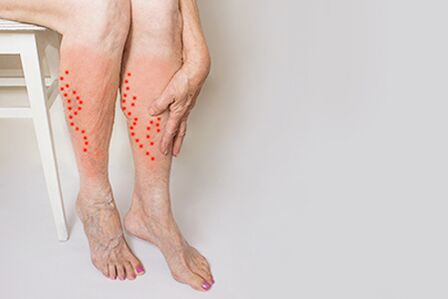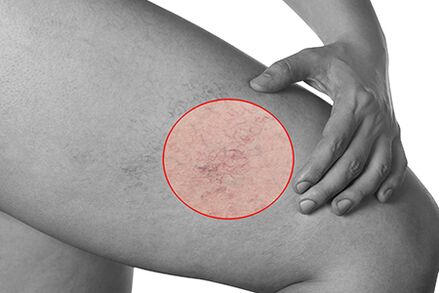If the veins on the legs are very large and clearly visible to the naked eye, this is not a reason for pride at all (well, in fact, these are not muscles). However, they don't look as attractive as, let's say, the quads. Therefore, most people usually hide them. Even by doctors. Which, by the way, is completely false. Because if you have problems with the condition of the veins and blood vessels, they should be shown to a doctor who specializes in them - a phlebologist. But first read this article - in it you will learn how to treat varicose veins in the legs, what symptoms it has and what procedures are performed to eliminate it.
Varicose veins of the legs: symptoms

Symptoms of this disease depend on its stage:
So, in the first stage, the patient is disturbed by a feeling of heaviness in the lower limbs, muscle cramps (more often during sleep), itching or burning, swelling of the legs. Sometimes there is pain in the legs, especially in the area of the veins. Telangiectasias are often present.
In the second phase there are the vascular networks and all the symptoms inherent in the first phase, but already more pronounced. In addition, the visibility of the veins is significantly increased: they can be observed even with the naked eye.
The third stage is characterized by all of the above symptoms. At the same time, the swelling becomes almost permanent. Sometimes they can pass in the morning, but at the same time reappear in the evening.
In the fourth stage, the skin color changes. It can turn brownish or even black. Inflammation appears, skin atrophy is possible. In this case, spots of a blue or purple hue appear on it.
At the fifth and sixth stages, a trophic ulcer is formed: healed and not healed, respectively.
Varicose veins of the legs: treatment
Today, the treatment of varicose veins in the legs can be done in several ways:
Laser obliteration of the veins. This is a high-tech procedure, which is performed using modern equipment - a medical laser device. The device is equipped with a flexible light guide, which is inserted through a puncture or incision into the lumen of the problem vessel to a certain depth. Next, the phlebologist turns on the apparatus and the tip of the light guide begins to emit a continuous stream of light. The light has such a wavelength that the rays are absorbed by the walls of the veins, so they heat up and weld together. Checking the implementation of the procedure with the help of an ultrasound laser allows you to treat varicose veins of the legs even more accurately and efficiently. After a while, the glued veins dissolve. The light guide has a special design, thanks to which the entire inner circumference of the ship is immediately processed. The required duration of treatment is achieved due to the fact that the doctor gradually extracts the light guide. Laser ablation has an average session duration of 2-4. 5 hours, but this drawback is offset by the fact that varicose veins can be treated with just one laser ablation session. And since the procedure requires a small incision (no more than 0. 3 cm), there is no need to suture after the session.
Miniflebectomy. This procedure will also require a puncture or incision (and also no more than 3 mm). It is necessary to extract the affected area of the vein. Subsequently, the phlebologist removes the extracted vein and its ends are compressed. Treatment of varicose veins of the legs with this procedure does not involve suturing, as the puncture is small - it is usually covered with a plaster and bandaged. This is enough for healing.
Sclerotherapy. For this procedure, it is not necessary to make an incision - the session is fully injectable. Using a syringe, a special liquid preparation (or in the form of a foam) is injected into the skin, which adheres to the walls of the veins. Just like in the case of laser venous obliteration, the glued vessel dissolves into the tissues after a while.
Surgical treatment of varicose veins in the legs. This is done using local anesthetics. During the operation, the doctor excised the skin in the area of the removed veins, after which he removes them. In addition, the cause of blood reflux is eliminated at the same time. After surgical treatment, a rather long recovery period is required, which is accompanied by mandatory dressings.
It is worth remembering that after all the procedures, it is necessary to follow some instructions that the doctor will give after completing them. So, it is necessary to abandon any kind of tanning, do not go to the sauna or bath for a couple of months after the treatment of varicose veins of the legs. It is also forbidden to remain in an upright or sitting position for a long time. A special time to achieve the effectiveness of the procedure, as well as in a faster rehabilitation period, is the use of compression underwear. At the same time, it is enough to comply with this rule around the clock in the first few days. In the future, compression underwear can only be worn during the day. By the way, at first even uncomfortable shoes (high heels, tight-fitting) will have to be abandoned. Two to three weeks after the procedure, it is recommended that you wear comfortable, spacious shoes.
Causes of varicose veins

One of the main reasons for the appearance and development of varicose veins in the legs, experts call a genetic predisposition. So, if a person in one of the relatives is diagnosed with varicose veins, the risk of this disease will be significantly higher than in people whose relatives did not suffer from varicose veins. However, there are several other factors that contribute to the development of varicose veins on the legs:
Sedentary lifestyle.
Wearing uncomfortable shoes or high-heeled shoes.
Leg injury postponed.
Greater loads: excess weight, weight lifting.
Wrong power supply.
Pregnancy and childbirth.
Diseases of the cardiovascular system.
Weakened vascular tone.
Taking certain hormonal drugs.
Smoking and alcohol abuse.
Diseases of the pelvic organs.
Constant stress and emotional tension.
High viscosity of the blood.
Varicose veins are more common in older people (because vascular tone decreases with age). However, it can also appear in young people up to 30 years of age. This disease affects both sexes.
Why it is necessary to treat varicose veins in the legs
If the elimination of varicose veins in the legs (treatment) is not carried out in a timely manner, various complications are possible, including a non-healing trophic ulcer. Subsequently, such an ulcer can cause gangrene, and this can already be fraught with lower limb amputation and disability. In addition, the treatment of any disease is easier to carry out in the initial stages of the disease.
Also, do not forget about the possible development of thrombophlebitis. One of the complications of this disease is pulmonary embolism, which can usually be fatal.
Prevention of varicose veins in the legs
A good preventative measure for varicose veins on the legs is to wear compression underwear that can provide even pressure across the entire surface of the legs. We also recommend that you follow other tips:
Do not neglect sports activities: cycling, swimming, walking, etc.
Avoid uncomfortable shoes (especially high heels).
Take a contrast shower.
Also, if you have a genetic predisposition to varicose veins (or other factors), see a phlebologist at least twice a year.



















